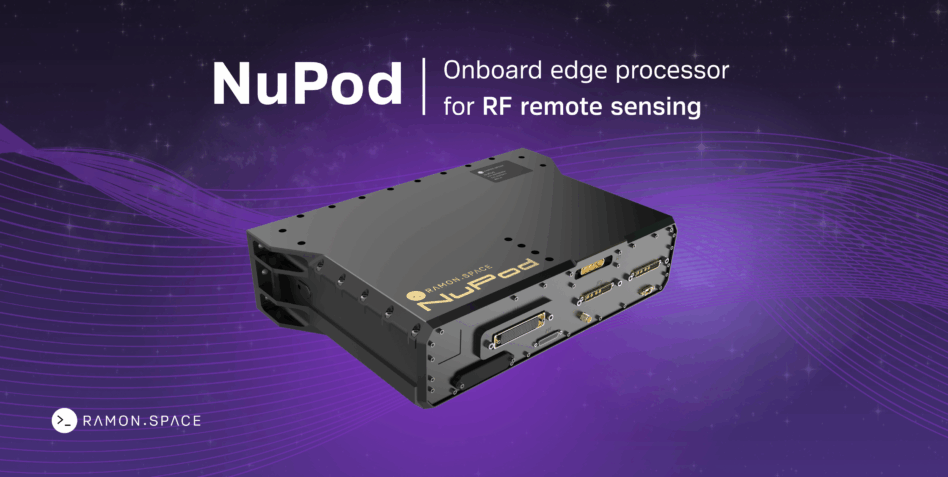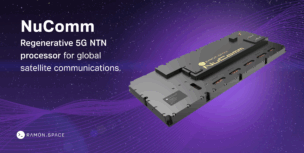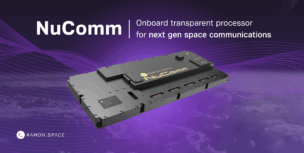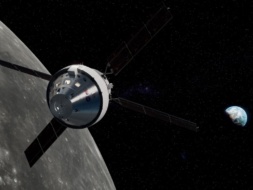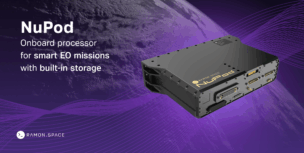Remote sensing missions produce vast amounts of data which need to be processed and transmitted safely and at speed. Unfortunately the limited bandwidth and system complexity of traditional ground-based processing systems make this level of efficiency extremely difficult to achieve.
A new approach is required. One that enhances data processing and transmits mission insights in real time. One that leverages edge computing and integrates RF capabilities to enable efficient data relay and autonomous decision-making.
NuPod, Ramon.Space’s onboard processor, delivers just that by combining high-capacity storage, advanced edge computing, and integrated RF capabilities into a single, digital platform.
NuPod: a software-defined system built for intelligent remote sensing missions
As remote sensing mission demands have become more and more complex – moving far beyond basic data relays – NuPod has stepped in to offer a modern, user-friendly system designed to fulfil these complex, and challenging needs.
With advanced storage and AI processing capabilities, NuPod delivers the onboard intelligence and resilient computing power essential to successful remote sensing missions:
- Unified Software-Defined Platform: NuPod integrates compute power, storage, DSP/AI functionality, custom interfaces, RF sensors, and RF downlink in a single modular system, to reduce complexity and increase operational flexibility.
- Multi-terabyte, High-Throughput Storage: NuPod integrates one or more NuStreams, our high-throughput, 1-terabyte storage system, with advanced edge processing to deliver a compact, high-performance storage system designed for data-intensive applications.
- Integrated RF Sensing: NuPod integrates custom RF front-ends for mission-specific applications including Signals Intelligence (SIGINT) and Synthetic Aperture Radar (SAR), supporting multiple RF ports and a variety of frequency bands from UHF up to Ka-band.
- Intelligent Edge Processing with Onboard Decision-making: By combining AI/ML capabilities and data processing of data from RF streams directly on the satellite, NuPod eliminates dependency on ground-based systems for primary processing, enhancing real-time decision-making capabilities and reducing data downlink requirements to free up valuable bandwidth.
- Advanced RF Signal Processing: NuPod addresses the unique data volume and bandwidth constraints of RF sensing missions by offering flexible, high-performance DSP capabilities optimized for various RF sensor operation modes and signal processing algorithms.
- Fully Reprogrammable In-Orbit Operations: NuPod allows operators to update mission parameters or deploy custom AI applications as requirements evolve. It also supports third-party application integration to tailor capabilities for specific RF sensing scenarios – extending mission utility without upgrading hardware.
- Space-Hardened Reliability: NuPod is built with Ramon.Space’s proprietary radiation-hardened silicon and technologies, to ensure sustained performance and survival in challenging space environments, whilst maintaining consistent RF sensing and processing capabilities.
Enhance RF sensing operations with NuPod
By integrating RF capabilities with storage and processing, remote sensing missions can achieve high performance and intelligent RF sensing platforms. From processing complex datasets to transmitting insights in real-time, NuPod enables autonomous decision-making and efficient data processing for a wide range of remote sensing applications, including:
- Signals Intelligence (SIGINT): From tracking tactical emitters to providing strategic situational awareness, NuPod extends the boundaries of what can be sensed from orbit. Represent a unique fusion of RF, digital signal processing, and resilient space system – transforming RF signals into actionable intelligence.
- Synthetic Aperture Radar (SAR): Onboard DSP/AI, storage and SoC-FPGA combined with high-end RF-FE enables advanced SAR application. NuPod can utilize a variety of SAR signal processing algorithms, enabling flexible transmission waveforms, data compression, and AI-driven feature extraction at the edge, reducing downlink volume and latency.
With its advanced Edge computing, AI-powered modular design, and integrated RF capabilities, Ramon.Space’s software-defined system enhances satellite processing capabilities and intelligence for EO, remote sensing, SAR, and other data-intensive missions.
For more information on Ramon.Space’s NuPod onboard processor, contact [email protected] or visit our website at www.ramon.space
